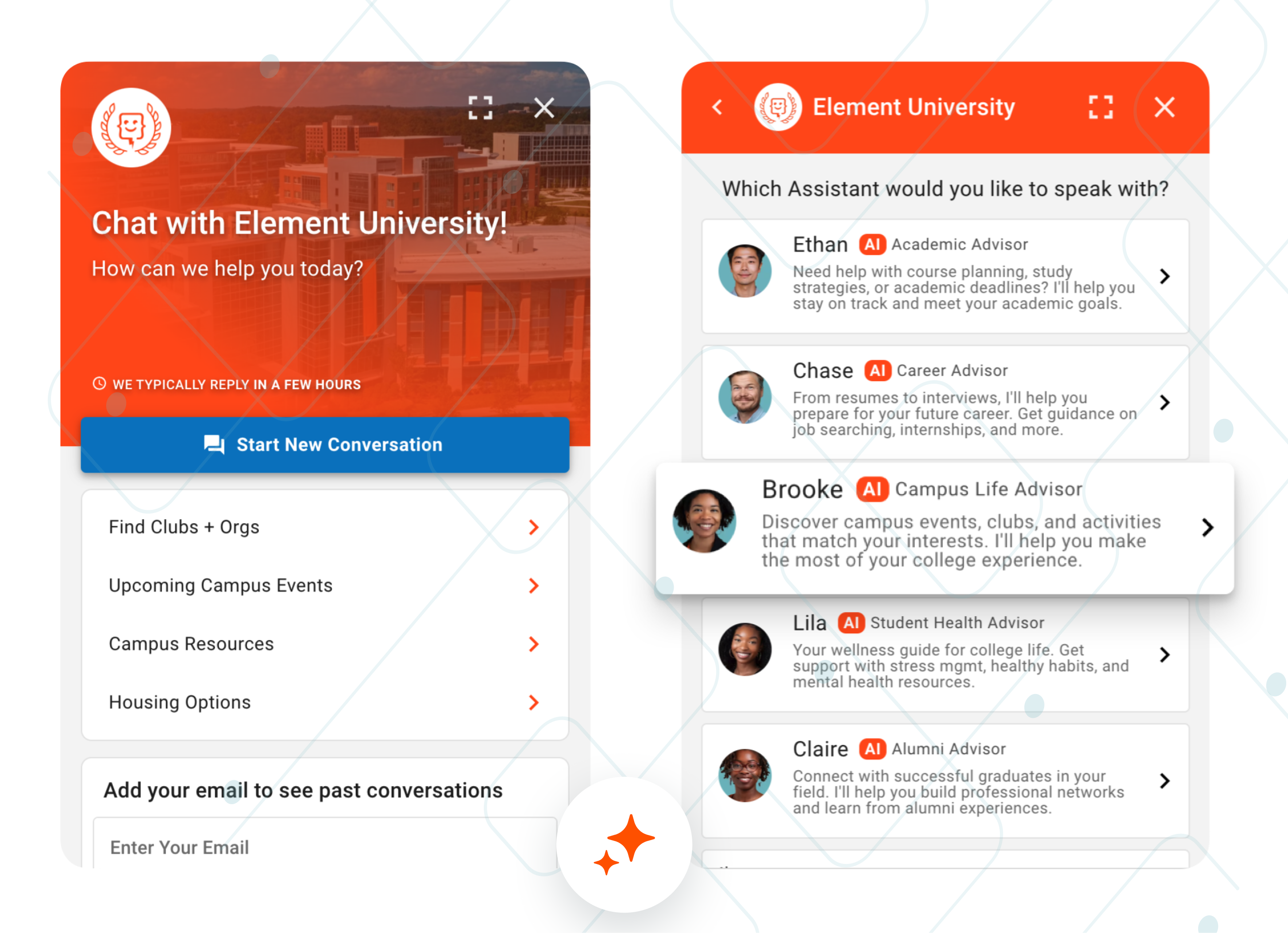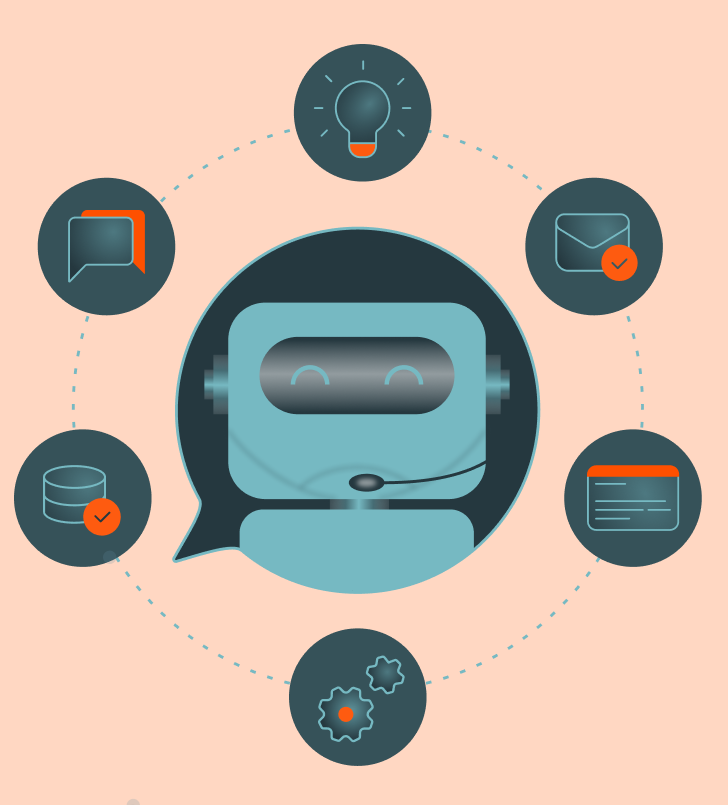The Role of AI Chatbots For Higher Education Success In 2024
by Brandon Hurter · Updated Nov 28, 2024

In the pursuit of growth and higher enrollment, educational institutions must align processes and automations with an ever-changing student audience. Leveraging an AI chatbot for higher education is a powerful way to provide personalized experiences effortlessly, eliminating the need for extensive manual interventions. So, what's the key to this seamless integration that paves the way for a positive learning experience?
Before you become skeptical about running your admissions marketing or handling student queries with autoresponders, let's start with the facts. The market's top chatbot tools are increasingly innovative, conversational, and driven by powerful artificial intelligence (AI) modals that offer many benefits. This means that you can still reach growth goals without leaving your students to the whims of a disjointed robotic voice.
If you want to save time and valuable resources with chatbot technology for higher education, you're in the right place. We’ll take a look at current examples, popular higher ed use cases, and tips for implementation within your student population.
What are Chatbots in Higher Education?
A “chatbot” refers to any tool or technology that uses automated artificial intelligence (AI) language processing to deliver real-time responses to individuals, customers, or students.
For higher education institutions, the foundational AI-fueled chatbot technology is the same as it is in other contexts or industries. At colleges and universities, AI technologies can replace routine and predictable communication that happens among students, staff, and even recruiters.
A higher ed chatbot relies on natural language processing (NLP), a system that supplies common language responses through a text-based interface. These exchanges or conversations can happen online in a browser, via text message, in-app, or even within a specialized chat-based engagement platform.
Common Uses Of AI Chatbots For Higher Education
Once a college or university decides to implement a chatbot platform or service provider, there are lots of unique ways to put that tool to work.
Website Lead Generation
An intelligent chatbot quickly connects with new website visitors and captures important contact information or other data from prospective students. These tools also help colleges and universities deliver instant information to leads by pointing individual students in the right direction, especially if they’re looking at certain degree options.
Enhancing Student Experience and Support Services
Chatbots deliver round-the-clock support to students by answering questions about academic concerns or other common needs. There are numerous examples of support at this level, including within the admissions office, financial aid or administration setting, IT ticketing system, and more.
A chatbot can engage students with fast, easy answers that help them continue in the learning process without added stress. In many cases, this is a preferred alternative to sitting on a long phone call, bouncing between faculty members, or traveling all over campus seeking assistance.
Data Collection from Inquiries
Because of the AI technology and natural language processing that powers them, chatbots are constantly taking in new student data and using it for future conversations, interactions, and analysis.
Schools can directly benefit from this incoming data by using it to improve the inquiry or educational experience, discover common pain points, and alleviate roadblocks during the enrollment process.
Admissions Assistance and Onboarding
AI chatbots simplify the admissions process by providing real-time guidance and resources to prospective students. From answering questions about application deadlines to helping students track their submission status, chatbots ensure no student feels lost in the process. They can also guide students through enrollment steps, like submitting required documents or registering for orientation, reducing the workload on admissions staff.
Additionally, during onboarding, chatbots can share important campus information, direct students to key resources, and even help them navigate their first days on campus. By offering immediate, accurate responses, chatbots create a smooth and welcoming onboarding experience.
Academic Advising and Course Recommendations
AI chatbots are becoming essential tools for academic advising by offering personalized course recommendations tailored to each student's program, goals, and progress. Students can quickly receive advice on prerequisites, credit requirements, or which classes to take to stay on track for graduation.
These chatbots can also identify and flag potential issues, like a student being at risk of falling behind in their academic plan, and direct them to advisors for further support. This proactive approach not only improves academic outcomes but also empowers students to take charge of their educational journey with confidence.
Benefits Of AI Chatbots For Higher Education
For institutions that have flourished without the use of chatbots in the past, implementing a new AI tool could seem risky. The investment is not only an important consideration for internal staff members, but it also has the potential to change student-forward experiences. Despite these potential concerns, there are several perks to introducing chatbot software in your admissions or enrollment workflow.
- Expanded student service options to increase student success. Chatbots give students access to valuable services at all times of day—not just when their advising contact happens to be online. Chatbots also offer a high level of detail for student inquiries and provide a tremendous amount of basic information that doesn't always require a one-to-one conversation.
- Cost savings. Many bottlenecks, delays, and communication gaps are preventable thanks to automation. Being able to connect students with answers while saving additional resources makes a tangible difference.
Reduction of mistakes and clerical errors. Chatbot experiences rely on learned and stored data. The responses that students receive are less likely to be affected by human mistakes, basic administrative errors, or mix-ups between individuals. Even with instant messaging, the accuracy rates for chatbots are generally high, with an industry standard of at least 80%.

Swipe, Tap, Submit: The College Experience Goes Personal to Boost Enrollment
Learn how to connect with today's students amidst one of the largest shifts in the history of higher ed.
Get the Report
Current Chatbot Trends in Colleges and Universities
As EdTech Magazine points out, the college-level conversation around AI has become increasingly prominent, particularly with the launch of ChatGPT and similar platforms. While many of these conversations center around AI ethics and questions in an academic context, the focus is on conversational artificial intelligence now more than ever.
In some examples, chatbots in higher education became necessary in order to deliver academic services during the COVID-19 pandemic. Without in-person interactions or classroom instruction, schools needed to communicate clearly and quickly. Automated tools and machine learning made these goals a reality, even when budgets and staff resources were cut for a time.
The latest chatbot uses have also allowed schools to move away from single-use bots into something more nuanced, personalized, and customizable. An artificially intelligent chatbot is highly adaptive and productive, which works well for a generation of students known as “digital natives.” Today's learners are not only familiar with this communication technology, but there's a growing need (on the institutional side) to help students embrace that knowledge as a way to persist to graduation.
As the Chronicle of Higher Education points out, leveraging chatbot technology assumes "generational specificity" by providing students with support in ways that suit their preferences and expectations.
How to Implement Chatbots at Higher Education Institutions
As with any other technology tool, automation, or marketing initiative, understanding what (and why) you’re launching is the key to success. If you plan to put chatbots in front of students, fine-tuning your process is critical.
Although your specific chatbot strategy might depend heavily on the direction of your campus leadership, follow these tips to achieve success and promote student satisfaction.
Make Your Chat Tool Engage Personally and Emotionally
In some cases, AI chatbots and other AI technology have gotten a bad reputation for being distant and impersonal—a far cry from genuine human interaction. But some of these common complaints are fading as technology improves. These advancements are often directly related to the ability of chatbots to communicate personally and empathetically. EdTech Magazine describes the changes as follows:
“As more universities have engaged with more students, chatbots have grown smarter and gotten better at building the kinds of relationships that have proved critical in driving retention, reducing summer melt and improving graduation rates at universities that implement them effectively.”
Your chosen chatbot solution must involve personalization. Even though you’re implementing automation to accomplish faster (and hopefully better) results, students should walk away from these encounters feeling supported and confident.
Offer Comprehensive Integrations to Assist Students
To be as effective as possible for diverse student populations, higher education chatbots also need to be smart and adaptive. Not only do these capabilities allow chatbots to reach underserved or hard-to-reach student populations, but better integrations make them easier to actually use, which can increase student engagement.
For instance, a chatbot might need secure access to other platforms that students use in order to answer questions accurately. One example is if the chatbot requires secure access to the student’s portal to provide answers on a financial aid account, registration, enrollment, or other administrative question.
It’s essential to maintain a chatbot’s other non-negotiable features, too.
- Chatbots should offer multi-channel communication. This means that students can connect from a variety of devices or platforms as they seek answers.
- All chatbot data must be highly secure to provide assurance about student privacy and sensitive data protection.
- Multilingual chatbot features expand access to support for diverse student populations; as the technology continues to evolve, it should also eliminate bias.
Define Your Strategy, Plan, and Boundaries for Educational Technology
Because artificial intelligence is still gaining steam in the higher education sector, having open and honest conversations about different ways to implement it is crucial.
Defining your college’s chatbot strategy, major goals, and benchmarks eliminates internal friction, can save resources, and often provides better student experiences.
Campus leaders should also seek buy-in for chatbot tools, since usage has ramifications across departments and teams. For example, a marketing team might rely on the website bot for initial inquiries, but those contacts get passed to recruiting. There must be alignment between teams so that collectively, the campus works toward common goals within the chatbot platform.
Future of AI Chatbots In Higher Education
At Element451, we believe that generative AI is here to stay—especially on diverse, inclusive college campuses that want to leverage the gold standard in technology. We’ve developed two essential technologies—Bolt Copilot and BoltBot—to drive your student engagement strategies even further this year.
>> Grab the Definitive Guide to AI in Higher Education <<
Bolt AI Assistants
BoltBot AI Assistants are a digital teammate - installed and configured on Element451 - that provides 24/7, task-specific support, helping you to bridge staff shortages while keeping every student on track. Build your ideal team of higher ed AI Assistants - tailored for any role, designed for any function, and customized entirely to support your goals.

See Bolt AI Assistants in Action
Revolutionize your work and support students with Element451's Bolt AI Assistants. It works 24/7 and understands the context and meaning behind every question providing accurate answers — every time.
Get a Demo
Increase Student Engagement with Element451’s AI Chatbot
Regardless of how you choose to communicate with current and prospective students, the non-negotiable rule is creating hands-on engagement. Because today's students readily grasp modern technologies (including chatbots), it’s wise to incorporate these features into the holistic recruitment and enrollment experience.
Element451 is on the leading edge of these exciting developments and tech trends. Our focus is on helping higher education institutions adapt the right way, and we're ready to chat!
>> Schedule an Element451 demo today. <<
Frequently Asked Questions (FAQs):
How does Element451’s AI Assistants compare to higher education chatbots?
Element451’s AI Assistant, powered by Bolt AI, goes beyond the capabilities of traditional education chatbots. While many chatbots focus on basic, pre-scripted responses, Element451’s AI Assistants are task-specific and persona-based, meaning they’re designed to handle specialized roles such as admissions advising or financial aid inquiries. This targeted approach ensures that interactions are not only accurate but also contextually relevant, providing a more personalized and efficient experience for students. Additionally, Element451’s AI Assistant integrates seamlessly with existing systems, offering multi-channel support and advanced data security, making it a comprehensive solution for higher education institutions.
Can AI chatbots replace human staff in higher education institutions?
AI chatbots are designed to complement—not replace—human staff. By handling routine, repetitive tasks such as answering common questions, managing applications, or scheduling appointments, AI chatbots free up staff to focus on more complex and meaningful engagements that require empathy, critical thinking, and nuanced problem-solving. The goal is to enhance the efficiency and capacity of human teams, allowing them to deliver a higher level of personalized support while maintaining strong student connections.

About Element451
Boost enrollment, improve engagement, and support students with an AI workforce built for higher ed. Element451 makes personalization scalable and success repeatable.
Categories
New Blog Posts

The Definitive Guide
AI in Higher Education
Bridge the gap between the latest tech advancements and your institution's success.
Useful Links

Talk With Us
Element451 is the only AI Workforce Platform for higher education. Our friendly experts are here to help you explore how Element451 can improve outcomes for your school.
Get a Demo








